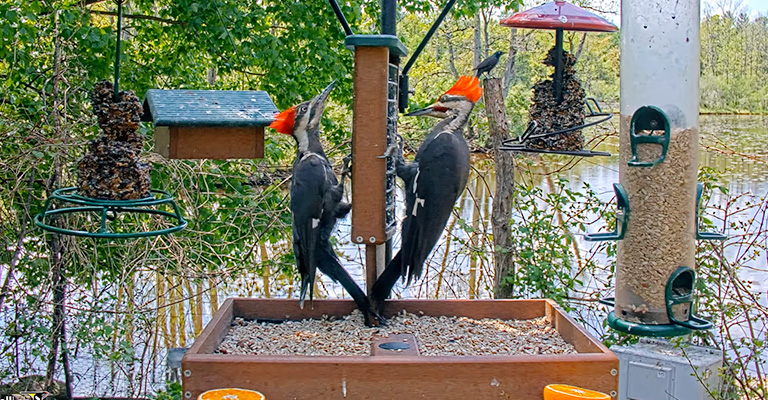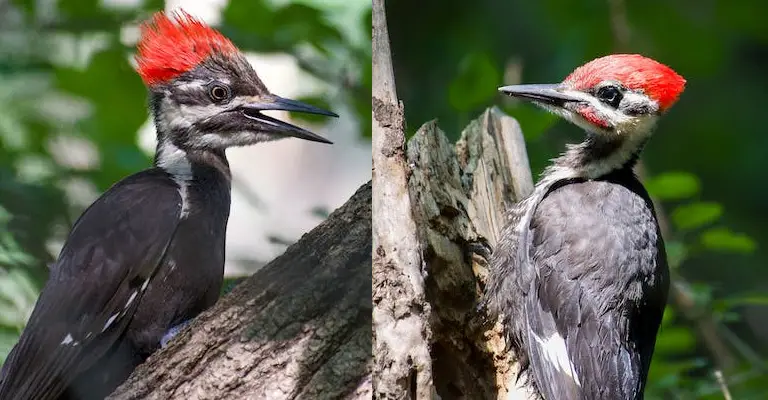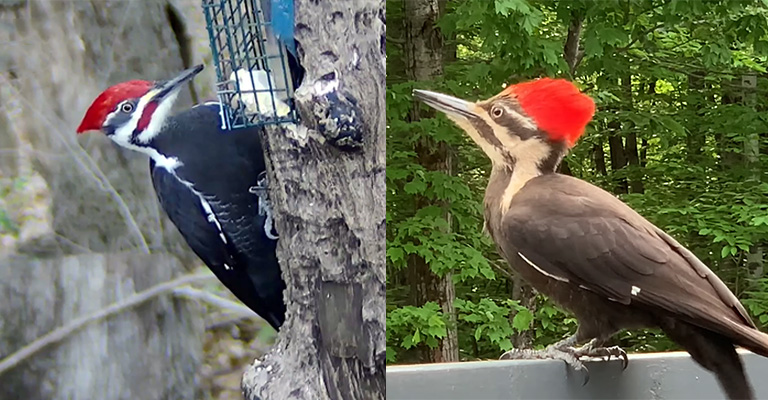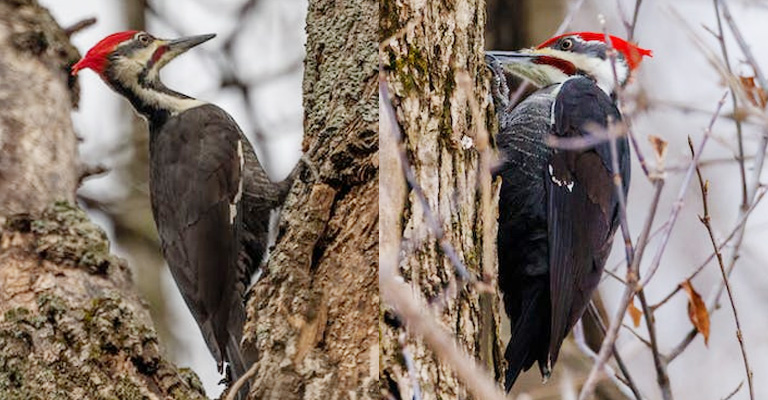The Pileated Woodpecker, a striking and unmistakable bird native to North America, presents intriguing differences between males and females. From crown coloration to chin strap presence, these distinct characteristics allow for gender identification.
There are many of us who fail to identify the gender of a pileated woodpecker even after having a year-long experience with birds. But there are some easy ways to identify their gender.
And that’s what we are going to talk about in today’s discussion. Make sure not to skip a single section.

Anatomy and Plumage
To differentia the male and female pileated woodpeckers, you need to understand a few essential factors of their anatomy. Here are the facts you need to check.
Crown Coloration
One of the prominent features of Pileated Woodpeckers is their vibrant red crest. Both males and females possess this striking crown coloration, but there are distinct differences between the two genders.
In males, the red color extends from the top of the head all the way down to their long bills, creating a continuous and uniform red crest. On the other hand, females have a different pattern of coloration.
The red color stops at the top of their heads, and the forecrown is either black or gray in color. This creates a clear contrast between the red crest of males and the black or gray forecrown of females.
Visual aids such as photographs can effectively demonstrate this contrast in crown coloration.
Chin Strap

Another characteristic that sets apart male and female Pileated Woodpeckers is the presence of a chin strap. Male woodpeckers have a red chin strap that extends from the bill, forming a distinct line of red feathers under their chins.
This red chin strap adds to their overall striking appearance. In contrast, females lack the red chin strap. Instead, their chin markings are either black or may not have any striping at all.
This difference in chin markings provides an additional clue for identifying the gender of Pileated Woodpeckers.
Crest Extension
The crest of a Pileated Woodpecker is an important feature that helps differentiate between males and females. In males, the crest extends all the way to the forehead, covering the entire top of their heads.
This creates a more pronounced and elongated crest that adds to their majestic appearance. On the other hand, females have a shorter crest that only extends to a point above the eye.
This shorter crest is one of the distinguishing characteristics of female Pileated Woodpeckers. By comparing the crest lengths between males and females, birdwatchers can accurately identify the gender of these woodpeckers.
Understanding the differences in crown coloration, chin strap presence, and crest extension can greatly assist birders and enthusiasts in correctly identifying the male and female Pileated Woodpeckers they encounter.
By paying attention to these distinct features, birdwatchers can gain a deeper appreciation for the unique beauty and diversity within this fascinating species.
Age and Development

There are significant differences between the male and the female pileated woodpecker in their growth and development. Here are some essential facts that will also help you understand their gender.
Crest Structure
One way to distinguish between adult and juvenile Pileated Woodpeckers is by examining the structure of their crests. Adult woodpeckers typically have well-developed, pointed crests that appear smooth and flattened out.
These crests contribute to the birds’ majestic and distinctive appearance. In contrast, juvenile woodpeckers exhibit variations in crest appearance. Their crests tend to be shaggier and less flattened out compared to adults.
The feathers may appear less organized and pointed, reflecting the ongoing growth and development of the crest. By observing the differences in crest structure, birders can gain insights into the age of the Pileated Woodpeckers they encounter.
Coloration Differences
The coloration of Pileated Woodpeckers can also provide clues about their age. Juvenile woodpeckers often exhibit variations in color compared to adults.
While adults typically have vibrant and well-defined plumage, juveniles may appear duller in color. Their feathers may lack the intense red hues seen in adult birds, and instead, their plumage may be more muted or have a slightly different shade.
This difference in coloration can be attributed to the maturation process, as the juveniles gradually develop vibrant adult plumage over time.
Visual examples, such as photographs or illustrations, can help birders understand and recognize the coloration differences between juvenile and adult Pileated Woodpeckers.
Field Identification and Birding Tips

I have some effective tips to identify male and female woodpeckers in sports. These tips must help you in this context.
Recognizing Male Pileated Woodpeckers
Male Pileated Woodpeckers possess several distinct features that can help identify them. One key characteristic is the presence of a red chin strap extending from the bill.
This unique feature creates a clear separation between the chin and the rest of the head markings. Additionally, males have an extended crest that covers the entire forehead, giving them an elongated and majestic appearance.
Their crown coloration is also vibrant and extends down to the bill, presenting a continuous and striking red plumage. Observing these key characteristics, along with their behaviors, can aid in recognizing male Pileated Woodpeckers.
In terms of behavior, male woodpeckers often engage in territorial drumming, creating loud and rhythmic sounds by hammering on tree trunks. They use this behavior to establish their presence and defend their territory.
Listening to the distinctive drumming sound and observing their vocalizations can provide further clues for identifying males.
Identifying Female Pileated Woodpeckers
Female Pileated Woodpeckers have their own set of characteristics that distinguish them from males. One key feature is the absence of a red chin strap.
Instead, females may have black stripes or no striping at all on their chin. Additionally, the crest of female woodpeckers is shorter compared to males, extending only to a point above the eye.
Their crown coloration is limited, with the red color ending at the top of their heads and the forecrown being black or gray. These features can help differentiate female Pileated Woodpeckers from their male counterparts.
When it comes to behavior, females may exhibit more focused foraging activities, searching for insects, and excavating for food. They may also engage in calls and vocalizations, which can provide additional clues for identification.
By paying close attention to the key characteristics and behaviors specific to each gender, birders can confidently identify male and female Pileated Woodpeckers in the field.
Developing a keen eye and ear for these distinctions enhances the overall birding experience and contributes to a deeper understanding of these remarkable woodpeckers.
Differences Between Male and Female Pileated Woodpeckers
| Characteristic | Male Pileated Woodpeckers | Female Pileated Woodpeckers |
| Crown Coloration | The red crest extends down to the bill | The red color stops at the top of the head |
| Chin Strap | Red chin strap extending from the bill | Black stripes or no striping on the chin |
| Crest Extension | Extends all the way to the forehead | Extends only to a point above the eye |
| Body Size | Generally larger in size | Generally smaller in size |
| Feather Structure | Smooth and pointed crests | Shaggier and less flattened-out crests |
| Plumage Coloration | Vibrant and intense colors | Duller and more muted colors |
| Forecrown Color | The red coloration on the forecrown | Black or gray color on the forecrown |
| Bill Size | Generally longer and more robust | Slightly shorter and less robust |
| Vocalizations | May have louder and more frequent calls and drumming | May exhibit quieter and less frequent vocalizations |
| Foraging Behavior | Engages in active foraging and excavation | Focuses on searching for insects and excavating food |
| Territorial Behavior | May exhibit more aggressive territorial behavior | May exhibit less aggressive territorial behavior |
| Nesting Responsibilities | May participate in excavating the nest cavity | Primary role in incubation and care of the nestlings |
| Juvenile Coloration | May have more muted or less intense plumage colors | May have similar coloration to adult females |
| Wing Span | Generally broader wing span | Generally slightly smaller wing span |
| Wingbeat Rhythm | May have a more distinct and powerful wingbeat | May have a slightly softer and lighter wingbeat |
| Tail Length | Generally longer and more prominent tail feathers | Slightly shorter and less prominent tail feathers |
| Tail Pattern | Red and black pattern on the tail feathers | Red and black pattern on the tail feathers |
| Flight Pattern | May exhibit more direct and powerful flight | May exhibit slightly more erratic flight |
| Habitat Preferences | Occupies various forested habitats | Occupies various forested habitats |
| Geographic Distribution | Found in North America and parts of Central America | Found in North America and parts of Central America |
FAQs
Differentiating between juvenile male and female Pileated Woodpeckers can be challenging as they may not exhibit the same characteristics as adults. However, you can still look for subtle differences such as crest length and coloration.
Males may have slightly longer and more vibrant crests, while females may have shorter and less intense coloration.
Yes, the coloration of Pileated Woodpeckers can change as they mature. Juveniles may have duller plumage compared to adults, and their colors may gradually become more vibrant as they reach adulthood.
It’s important to consider age-related variations when identifying these birds.
Pileated Woodpeckers do not typically exhibit significant sexual dimorphism in size. While there may be slight variations between males and females, such as males being slightly larger on average, the size difference is generally not as pronounced as in some other bird species.
Vocalizations can provide valuable clues for identifying male and female Pileated Woodpeckers. Males often produce louder and more frequent calls, including territorial drumming, to establish their presence.
Females may have quieter vocalizations and exhibit different behaviors. Familiarizing yourself with their distinct vocalizations can aid in gender identification.
End Call
Distinguishing between male and female Pileated Woodpeckers involves noting key characteristics such as crown coloration, chin strap presence, and crest extension.
These features, along with behavioral cues, aid in accurate identification in the field. Understanding these differences enhances the birding experience and fosters a deeper appreciation for the unique beauty of these remarkable woodpeckers.
Hopefully, you will have no more issues understanding the gender of the pileated woodpecker. For any related questions, you can leave a comment. We’ll definitely come back to solve it. Have a nice day.